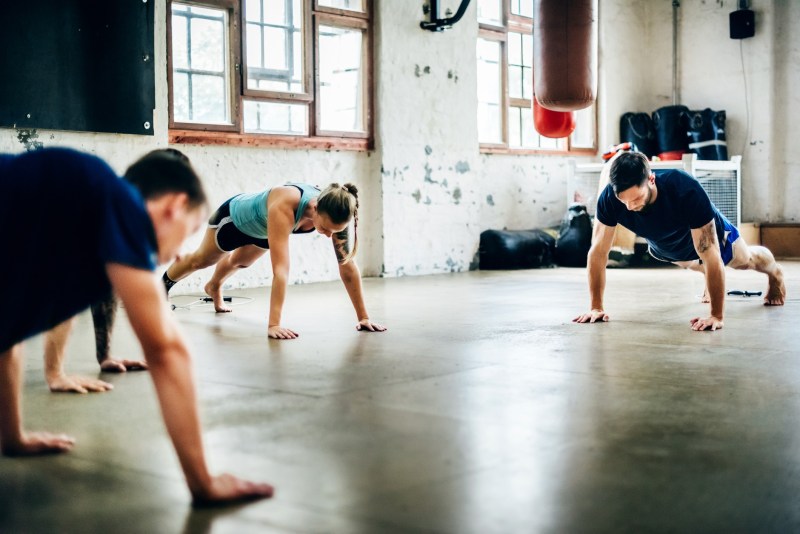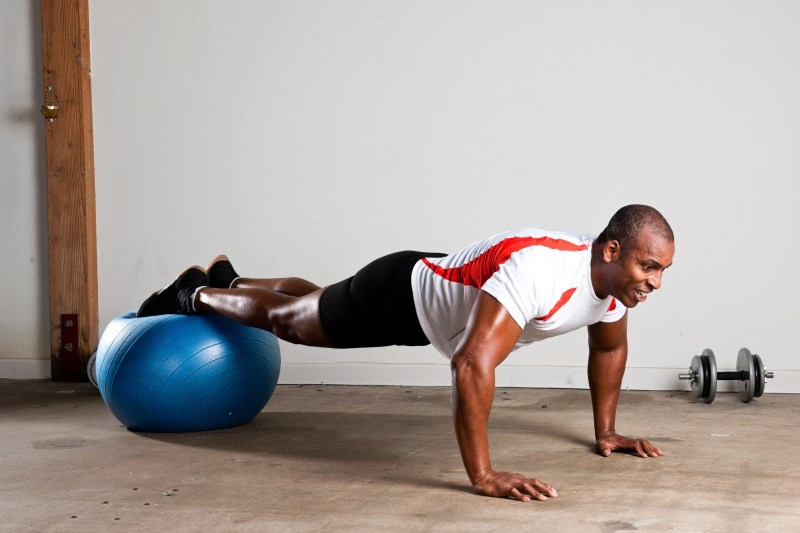
Whether you love them or hate them, push-ups are a foundational exercise that has numerous benefits and is a mainstay in many of the best workouts. Push-ups strengthen the triceps, shoulders, chest, upper back, and core all while requiring no equipment and minimal instruction. They can also improve cardiovascular fitness if reps are completed quickly and to exhaustion.
Once you know how to do a push-up, it can also be modified and progressed to more difficult variations, which is a definite perk for more experienced athletes and fitter individuals. By altering hand placement or tweaking the movement pattern itself, it’s possible to change the muscular demands and the difficulty of a standard push-up for variety and a greater strengthening stimulus to your workout. As one of the primary tenets of getting stronger is continually changing your workouts and making them progressively more difficult, incorporating variations on the standard push-up is an effective way to ensure you see results from your workouts while simultaneously preventing boredom. If you’ve mastered the basic push-up and feel ready to kick things up a notch, clear some space on the floor and give these 8 challenging push-up variations a try.
Push-Up Holds

Each rep in this push-up variation includes an isometric hold or static time under tension.
Equipment
None.
Technique
- Get into the standard push-up position and lower your body as you would with a normal push-up.
- Instead of immediately pressing back up to the starting position, pause and hold yourself in the lowered position for 10 to 20 seconds.
- After completion of the isometric holds, press back up into the starting position and lower back down again into the hold.
- Gradually increase the length of time that you hold yourself in the lowered position.
- Complete 10 to 20 reps.
Stability Ball Push-Ups and Tucks

One way to increase the difficulty of a standard push-up is to work against more gravity. Just as doing a push-up with your hands on a wall makes a push-up easier by reducing the force of gravity you have to work against, elevating your feet relative to your hand ramps up the difficulty by fighting against more gravity. Moreover, by placing your feet up on a stability ball in this particular push-up variation, you’ll also have to engage your abs to stabilize and balance your body to prevent yourself from falling off the ball. Adding a tuck between push-ups further utilizes the core.
Equipment
Stability Ball
Technique
- Get in a push-up position with your arms slightly wider than shoulder-width apart and your feet behind you on a stability ball with the laces portion of your shoes in contact with the ball.
- Keeping your glutes and abs engaged, perform a push-up, being sure to bring your chest as low as you can go without touching the floor.
- When you’re back in the starting position, before moving into the second rep, engage your glutes, hip flexors, and abs to pull your knees forward towards your chest, rolling the ball forward toward your hands.
- Untuck your legs and straighten them back out to the starting position.
- Complete another push-up.
- Alternate between push-ups and tucks.
- Complete 20 cycles.
Spider-Man Push-Ups

You’ll work your obliques and abs while also improving hip mobility with this dynamic push-up.
Equipment
None.
Technique
- Assume a standard push-up position with your hands slightly wider than shoulder-width apart.
- Your arms should be angled such that instead of bending your elbows straight out to the side, you want your elbows to bend about halfway between out to the side and straight back (picture aiming them at the 4 and 8 on a clock).
- As you lower your chest to the floor, lift your left leg off the ground, bending your knee and bringing your leg forward so that your knee comes up to your right elbow.
- Pause in the lowered position without touching the floor with your chest. Continue holding your leg up by your elbow.
- Push back up, returning your leg to the starting position.
- Alternate legs and complete 10-20 reps per side.
Thoracic Rotations Push-Ups

This push-up variation is great for the whole core—especially the obliques—as well as your shoulders. It’s also a mobility exercise for your spine, and helps improve your balance. Use hex dumbbells (if available), to make the exercise more difficult, though it can be done without added resistance as well.
Equipment
Two hex dumbbells (5-10 pounds each) – optional
Technique
- Start in a standard push-up position with your core tight and glutes engaged and your hands gripping two hex dumbbells (5-10 pounds each) planted on the floor.
- Complete one full push-up, and when you’re back in the starting position, shift your weight onto your right hand and lift your left hand off the ground, rotating your spine and pivoting your feet enough so that your whole torso is facing the left wall and your left arm is pointing towards the ceiling with the weight in that hand held up in the air. Your body should be in a “T” position.
- Hold this position for a full breath and then return to the push-up position.
- Switch sides and complete 12-20 reps per side.
Plyometric Push-Ups

This variation can be equated to the jump squat of push-ups. Essentially, you’ll clap in between each push-up, meaning you actually have both hands off the ground simultaneously and then have to absorb the impact as with plyometric jumps. You’ll get your heart rate up while adding the rigor of impact forces to the muscular demand.
Equipment
None.
Technique
- Start in a standard push-up position.
- Lower your body as you would with a normal push-up by bending your elbows.
- On the way up, press forcefully into the ground so that your entire upper body and hands are airborne but your feet remain on the ground.
- Rapidly clap your hands together once under your chest and then get them back into position—shoulder-width apart—to catch you on your landing.
- Move seamlessly into the next push-up by bending your elbows and dropping your chest towards the ground without fully touching it.
- Complete 10 to 25 reps.
Diamond Push-Ups

By moving your hands all the way to the center under your chest in this narrow-grip push-up, you’ll increase the difficulty of stabilizing your body, which requires more core activation, while also transferring more of the load to your pecs (chest), anterior deltoids, and triceps. Note that if it is too difficult to complete the full range of motion with your hands touching one another, you can work up to this challenging position by gradually reducing the distance between your two hands on a standard push-up.
Equipment
None.
Technique
- Get into the standard push-up position, but instead of placing your hands shoulder-width apart, move them in toward the center such that your fingertips and thumbs touch and form a diamond in the middle.
- From this position, lower your chest toward the ground by bending your elbows until they are flexed to a 90-degree angle. You should feel more stress on your triceps.
- Press through your palms to return to the starting position.
- Complete 10 to 25 reps.
Medicine Ball Staggered Push-Ups

This fun variation on the standard push-up turns the bilateral exercise into a bit of a unilateral exercise. Although you will still be moving both sides together, because one arm is elevated relative to the other, the distribution of forces is different and makes for a more challenging exercise. Therefore, this modification requires a lot more core strength and single-arm strength.
Equipment
Medicine ball.
Technique
- Grab a medium sized medicine ball and place it under your right hand in the standard push-up position.
- Complete one push-up.
- After you are back in the starting position, roll the medicine ball to the left hand and place the left hand on top of the ball.
- Complete another push-up and then roll the ball back to the right side.
- Continue alternating sides between each rep until you have completed 24 to 50 reps.



